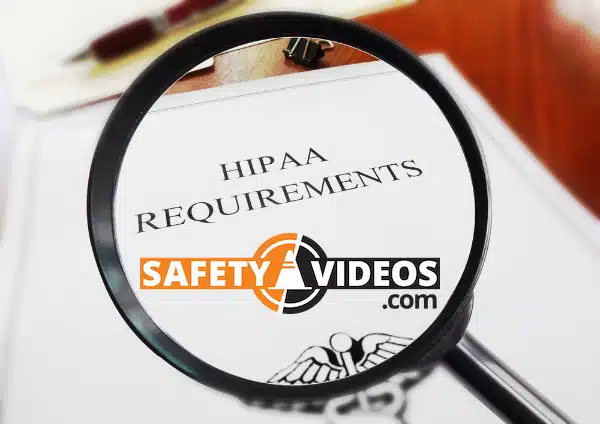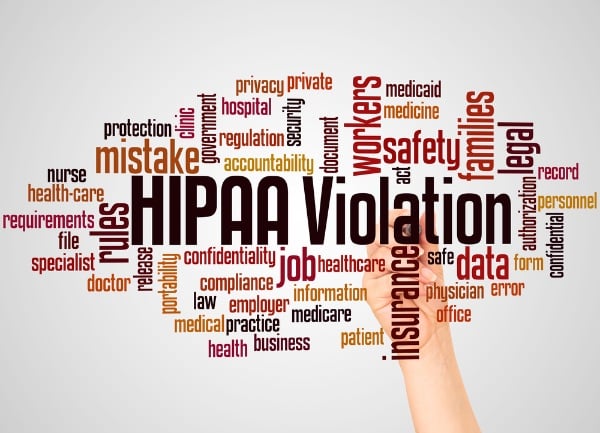HIPAA Privacy Rule – Key Components To Stay Compliant

As the industry becomes increasingly reliant on health information technology and the data transfers of personal information, protecting the privacy of sensitive data has never been more critical.
The Health Insurance Portability and Accountability Act (HIPAA) Privacy Rules serve as crucial physical safeguards against data breaches for healthcare providers and their patients.
So what are the key components of the HIPAA Privacy Rule that you need to know?
This HIPAA Privacy Rule summary will cover three essential elements of HIPAA compliance, including understanding which parties are covered by the rule, knowing which details are protected, and how an individual’s medical information may be used and disclosed. This information is also included in our HIPAA training course as well.
Introduction to the Health Insurance Portability and Accountability Rule
The Privacy Rule is a code of nationally-held standards that protects select information about patient health. It was created by the United States Department of Health and Human Services to put into action the Health Insurance Portability and Accountability Act.
These stipulations help ensure that health information, also known as “protected health information,” is kept private by organizations – called “covered entities” – that must follow these policies and procedures.
As such, the Privacy Rule also gives individuals control over how and with whom details about their health are shared.
The overarching goal of this security rule is to make sure that health information is kept safe while also allowing the necessary sharing of information to provide good health care and protect the public. In other words, the goal is to strike an appropriate balance between protecting privacy and permitting necessary data disclosures.
Since there are many different kinds of healthcare services, the Privacy Rule is intentionally flexible and covers all the ways health information must be shared.
With this short overview out of the way, let’s fully submerge into the realm of the HIPAA Privacy Rule and discuss the three components you must be aware of in order to understand your rights pertaining to data security and privacy practices.

1. Which Parties Are Covered Under the Privacy Rule?
The HIPAA regulations apply to a few types of organizations: health plans, healthcare clearinghouses, and healthcare providers who send health information electronically to facilitate specific types of transactions. These organizations are known as the previously mentioned covered entities.
If you work for a healthcare provider, health plan, or any other form of the covered entity and you send health information electronically, the Privacy Rule most likely applies to you.
Health Plans (Health Insurance Coverage)
Firstly, the HIPAA regulations apply to healthcare plans that cover costs associated with medical care. That includes medical plans as varied as general health, vision, dental, and insurers of prescription drugs, as well as government-funded plans like Medicare and Medicaid.
Some plans – like those with fewer than 50 participants and solely administered by an employer – may be exempt from the rule. It’s worth noting that certain insurance entities, like workers’ compensation and automobile insurance, are not considered healthcare plans under HIPAA policies and procedures.
Should an insurance company offers both healthcare and non-healthcare plans, the regulations only apply to the healthcare plans. The security rule does not cover programs that don’t primarily provide or pay for healthcare, like food stamps.
Health Care Providers
HIPAA rules apply to all healthcare providers – no matter how big or small – if they use electronic methods to send health information during certain transactions such as claims, eligibility inquiries, or requests for referral authorization.
This means that just because a provider uses email doesn’t automatically make them a covered entity under HIPAA enforcement rules.
However, they must comply with the Privacy Rule if they electronically transmit health information to facilitate one of these standard transactions.
The rule applies to health insurance coverage professionals who directly transmit the information themselves or who use a billing service or other third party to transmit the data for them. As such, “healthcare providers” refer to both institutional providers, like hospitals, and non-institutional providers, like general practitioners or dentists.
In sum, the security rule covers anyone who provides, bills or generates income from healthcare services.
Business Associates
In the context of HIPAA security, business associates are people or organizations that do certain tasks or provide certain services on behalf of a given covered entity that involves using or sharing a patient’s electronically protected health information.
These tasks include things like processing claims, analyzing data, and billing. However, if the person or organization doesn’t need to use or share the patient’s PHI, they don’t qualify as business associates.
When a healthcare provider works with contractors or an outside organization to do these tasks, they need to sign a business associate agreement that includes certain rules to protect the patient’s PHI.
Business associate contracts are a crucial aspect of maintaining information security. To ensure HIPAA compliance, the healthcare provider must ensure their business associate doesn’t do anything that breaks the rules.
Health Care Clearinghouses
Healthcare clearinghouses are companies that process healthcare information from one form into another that can be more easily read and understood. These companies usually only receive PHI when they are hired to help process that information for a health plan or provider.
When they do receive that information, however, they have to follow certain rules to make sure the information is protected. Examples of these companies include billing services, repricing companies, and information systems.

2. What Types of Information Are Under Protection?
Protected Health Information
HIPAA policies and procedures make sure that any information about a person’s health – including that which can be used to figure out who that person is – is kept private and secure. This information is called “protected health information (PHI)”, or personal health information. The key point is to make sure that any medical information is kept secure, and that any breach requires notification to the authorities.
This data can come in different forms, such as electronic, paper, or oral. Individually identifiable health information can include things like someone’s medical history or the payments for their healthcare.
If a person’s name, birth date, social security number, or address can be used to figure out who they are, then that information is also considered identifiable health information.
Some data, like employment records in an employer’s possession, your National Provider Identifier (NPI), and education records, are not protected by HIPAA’s information security provisions.
De-Identified Health Information
When it comes to your electronically protected health information, some parts can be shared without your permission. This is called “de-identified” health information, and it doesn’t contain any details that could point to you specifically.
There are two methods to make patient information “de-identified.”
First, a statistician can take a look and confirm that there’s no way someone could figure out what the information is about.
Second, certain pieces of information (like your name, relatives, or employer) are taken out. As long as the rest of the information can’t be linked back to you, it’s considered de-identified.
3. Permitted Uses and Disclosures
HIPAA allows health insurance providers to share your patient information for specific reasons without obtaining your permission. In this section, we’ll explore all of the six instances in which healthcare entities are allowed to share an individual’s health information.
To the Individual
Firstly, let’s state the obvious: a covered entity is allowed to share this information with the person it’s about. So, if you want to know what your doctor wrote on your medical chart or see your lab results, they can share that information without risking any legal repercussions.
Treatment, Payment, or Healthcare Operations
When it comes to your PHI, there are certain situations where it can be used or shared without your explicit permission. These situations are called Treatment, Payment, or Healthcare Operations.
In certain situations, a healthcare provider or insurance company can share your PHI with another provider or entity for their own treatment, payment, or healthcare operations activities, as long as both entities have a relationship with you and your PHI is relevant to that relationship.
TREATMENT
Treatment refers to when your healthcare provider needs to access your PHI in order to provide you with medical care. For instance, if you have a broken arm, your doctor must access your medical history to ensure they provide appropriate care.
PAYMENT
Payment refers to situations where your PHI is used for billing and payment purposes. For example, your insurance company needs access to your medical records to process and pay your medical bills.
HEALTH CARE OPERATIONS
This includes activities that healthcare organizations and insurance companies undertake to ensure that the healthcare system runs smoothly.
This can include quality assurance activities to ensure that patients receive the best care possible or fraud and abuse detection activities to prevent misuse of the healthcare system.

Uses and Disclosures Given the Opportunity to Agree or Object
Sometimes, you can get permission to use or share personal information casually by just asking someone directly.
Other times, the situation might make it clear that the person is okay with it, or they might say something that indicates they’re not okay with it.
FACILITY DIRECTORIES
Many healthcare facilities keep a list of patient information called a facility directory. If you’re a patient, the healthcare provider might ask if it’s okay to include your name, location, condition, and religious affiliation on this list. If you say yes, anyone who asks for you by name can find out your general condition and where you are in the facility.
If you’re religious, the provider can also tell clergy members what religion you are without them having to ask for you by name.
FOR NOTIFICATION AND OTHER PURPOSES
Sometimes, a covered entity might need to share your medical information with your family, relatives, friends, or with other people who you identify as being involved in your care or who are helping to pay for your care.
For example, if you’re unable to pick up a prescription from the pharmacy, a pharmacist might be able to give it to someone you trust, like a family member.
But don’t worry, your healthcare provider won’t just share your medical information with anyone. They’ll only share the patient information that’s necessary and relevant to the situation, and they’ll do their best to protect patient data in accordance with HIPAA’s privacy practices.
Incidental Use and Disclosure
When it comes to sharing your patient information, there are some cases where it might accidentally slip out – this is called “incidental use and disclosure.” Though strict, HIPAA’s security rule doesn’t expect everything to always be perfect.
If your health data is accidentally shared in a way that was allowed or expected – like sharing it with a doctor or nurse during treatment – it’s okay, provided the people who shared it tried their best to keep it safe and only shared what they had to. This means they followed the Privacy Rule to the best of their ability and only shared the “minimum necessary” information.
Public Interest and Benefit Activities
The HIPAA Privacy Rule allows for some situations where your health information can be used and shared without your permission. These situations are called “public interest and benefit activities,” and there are twelve of them.
They’re important because they help people outside the healthcare industry, but they’re also limited in protecting your privacy. Each situation has its rules to ensure your privacy is balanced with the public’s benefit.
Even though your permission may not be needed for these uses, the Privacy Rule still makes sure that your privacy is respected.
These twelve situations are the following:
- As required by law
- Relevant to public health activities
- Pertaining to victims of abuse, domestic violence, or neglect
- Activities relating to a health oversight
- For the purposes of law enforcement
- Involving decedents
- Involving cadaveric tissue, eye, or organ donation
- For medical, scientific, or pharmaceutical research
- When there is a serious threat to personal safety or health
- For essential functions of government
- To assist judicial and administrative processes
- Workers’ compensation cases

Limited Data Set
A “limited data set” is a type of PHI that has had certain identifying details removed, like names or addresses. This type of information can be used for research, healthcare operations, and public health purposes, but the person or organization receiving the information has to promise to keep it safe and not share it with anyone who isn’t supposed to see it.
It goes without saying that these limited data sets help protect people’s privacy while still allowing important research and public health work to be done.
Closing Thoughts
As we continue to navigate the ever-changing landscape of high-quality health care, it is vital that we prioritize the protection of sensitive health information.
The HIPAA Privacy Rule provides a framework for doing so, but ultimately it is up to healthcare organizations, patients, and policymakers to ensure that privacy remains a top priority.
Frequently Asked Questions
What are the 3 key parts of the HIPAA Privacy Rule that apply to long-term care settings?
The HIPAA Privacy Rule applies to a wide range of healthcare settings, including long-term care facilities. There are three key parts of the HIPAA Privacy Rule that are particularly relevant in this context:
- Protected Health Information (PHI): The Privacy Rule covers all individually identifiable health information held or transmitted by a covered entity or its business associate. In a long-term care setting, this could include medical records, medication lists, and care plans for residents.
- Permitted Uses and Disclosures: The Privacy Rule outlines when PHI may be used or disclosed without patient authorization. For instance, PHI and patient records may be disclosed for treatment, payment, or healthcare operations purposes. In a long-term care setting, PHI may also be disclosed to family members or other caregivers involved in a resident’s care.
- Minimum Necessary Standard: The Privacy Rule requires covered entities to limit their use, disclosure, and requests of PHI to the minimum necessary to accomplish the intended purpose. In a long-term care setting, this means that workforce members should only access PHI that is necessary for them to provide care to residents and should limit access to more information than is required for their job responsibilities.
What’s the difference between the HIPAA Privacy Rule and the HIPAA Security Rule?
The Privacy Rule is a comprehensive set of guidelines that covers safeguarding Protected Health Information (PHI) in all forms, including physical access, electronic, paper, and even oral communication.
The HIPAA Security Rules are more focused on device security and data and technical security requirements. As such, the Security Rule defines the guidelines for a healthcare provider to maintain reasonable protection of electronic PHI (ePHI) that is created, received, used, or maintained.
In other words, while the Privacy Rule takes a holistic approach to restricting access to PHI in all forms and their physical security, HIPAA Security Rule compliance is primarily concerned with the protection of electronic health records by security personnel.
Does the Department of Health and Human Services (HHS) enforce HIPAA rules?
The enforcement of the HIPAA Privacy and Security Rules is overseen by the Office for Civil Rights (OCR) within the Department of HHS. For most covered entities under HIPAA, enforcement of the Privacy Rule officially began on April 14th, 2003.
This means that the OCR has been working for over two decades to ensure that healthcare organizations are in compliance with the rules and that patient privacy is protected.